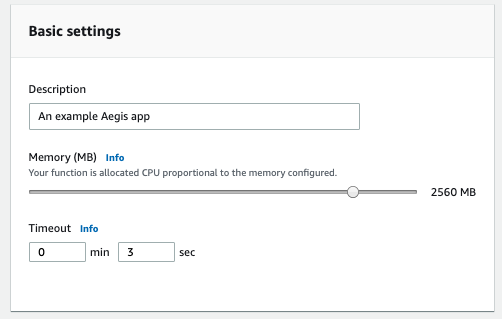Aegis
Aegis is both a simple deploy tool and framework. Its primary goal is to help you write microservices in the AWS cloud quickly and easily. They are mutually exclusive tools.
Aegis is not intended to be an infrastructure management tool. It will never be as feature rich as tools like Terraform. Its goal is to assist in the development of microservices - not the maintenance of infrastructure.
Likewise the framework is rather lightweight as well. It may never have helpers and features for every AWS product under the sun. It provides a conventional framework to help you build serverless microservices faster. It removes a lot of boilerplate.
Getting Started
You'll need an AWS account of course. You'll also want to have your credentials setup as you would for using AWS CLI. Note that you can also pass AWS credentials via the CLI or by setting environment variables.
Get Aegis of course. Use the normal go get github.com/tmaiaroto/aegis. Ensure the aegis binary is in your executable path. You can build a fresh copy from the code in this repository or download the binary from the releases section of the GitHub project site. If you want to use the framework though, you'll need to use go get anyway.
You can find some examples in the examples directory of this repo. Aegis also comes with a command to setup some boilerplate code in a clean directory using aegis init. Note that it will not overwrite any existing files.
Work with your code and check settings in aegis.yaml. When you're ready, you can deploy with aegis deploy to upload your Lambda and setup some resources.
Aegis' deploy command will set up the Lambda function, an optional API Gateway, IAM roles, CloudWatch event rules, and other various triggers and permissions for your Lambda function. You're able to choose a specific IAM role if you like too. Just set it in aegis.yaml.
If you're deploying an API, the CLI output will show you the URL for it along with other helpful information.
The Aegis framework works by handling events (how anything using AWS Lambda works). The way in which it does this though is via "routers." This means your Lambda is actually able to handle multiple types of events if you so choose.
Many people will want to write one handler for one Lambda, but that's not a mandate of Lambda. So feel free to architect your microservices how you like.
There are several types of routers. You can handle incoming HTTP requests via API Gateway using various HTTP methods and paths. You can handle incoming S3 events. You can handle scheduled Lambda invocations using CloudWatch rules. You can even handle invocations from other Lambdas ("RPCs").
Building
It's easiest to download a binary to use Aegis, though you may wish to build for your specific platform. In this case, Go Modules is used. Easiest thing to do after cloning is:
GO111MODULE=on go mod download
Then build:
GO111MODULE=on go build
Unfortunately you can't do a straight go build because of one of the packages used. You'll get errors. So using Go Modules is the way.
Contributing
Please feel free to contribute (see CONTRIBUTING.md). Though outside of actual pull requests with code, please file issues. If you notice something broken, speak up. If you have an idea for a feature, put it in an issue. Feedback is perhaps one of the best ways to contribute. So don't feel compelled to code.
Keep in mind that not all ideas can be implemented. There is a design direction for this project and only so much time. Though it's still good to share ideas.
Running Tests
Goconvey is used for testing, just be sure to exclude the docs directory. For example: goconvey -excludedDirs docs
Otherwise, tests will run and also include the docs folder which will likely have problems.
Alternatively, run tests from the framework directory.








